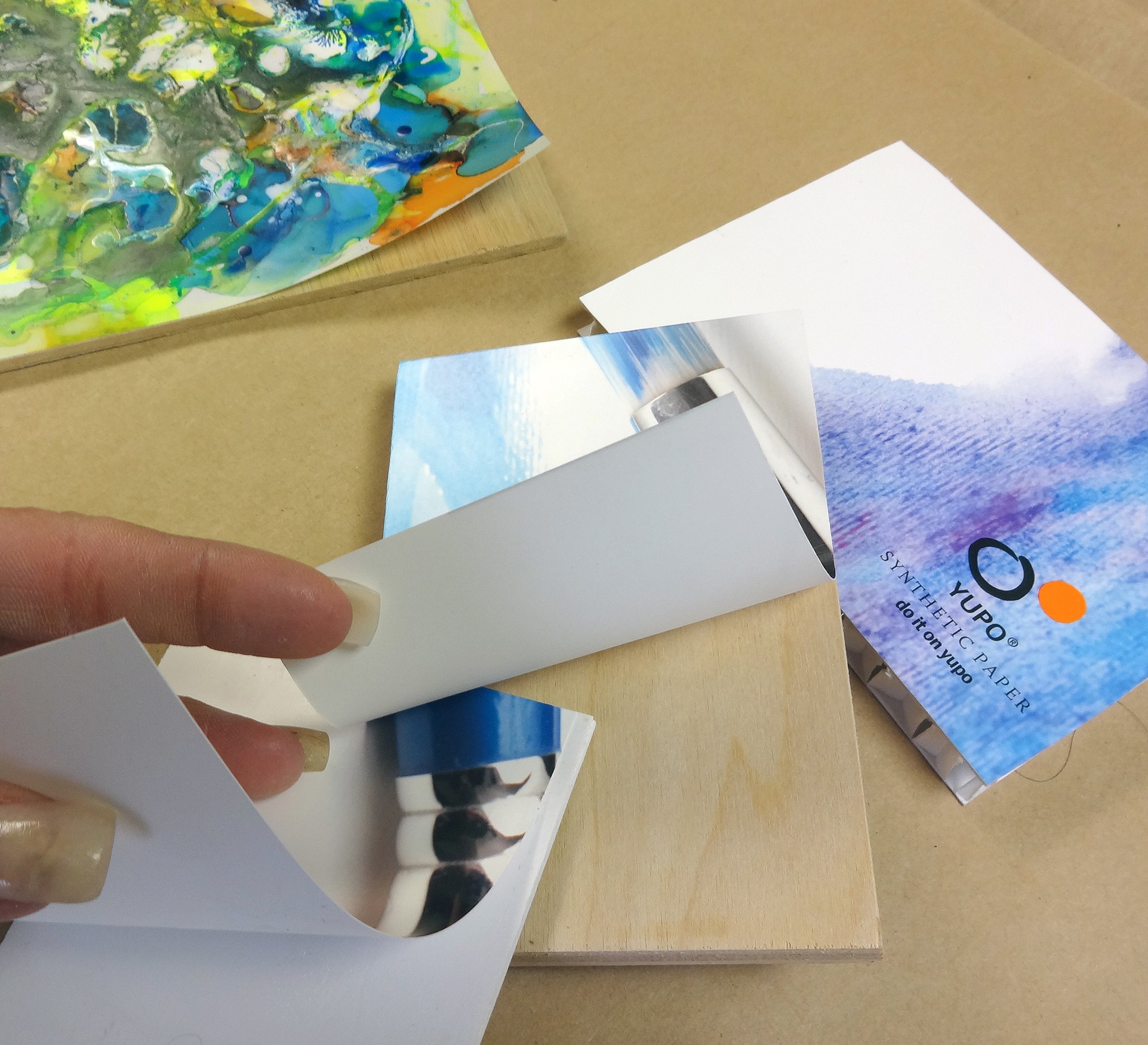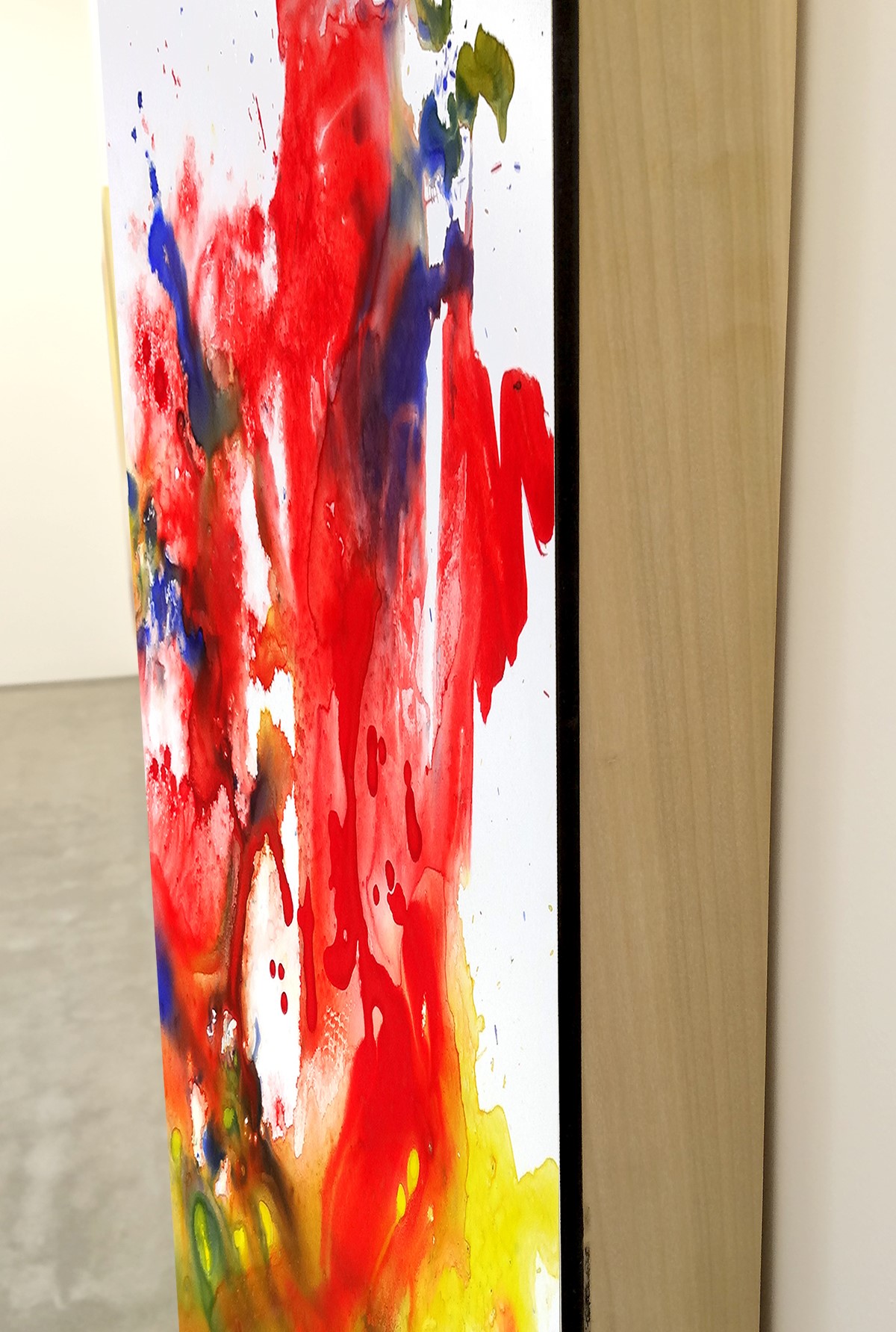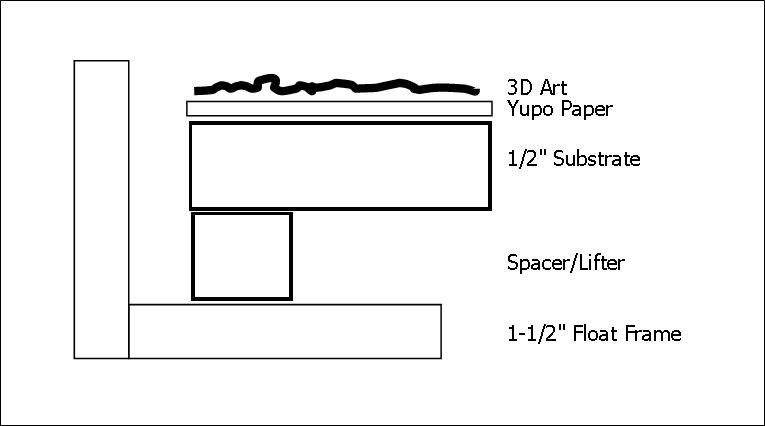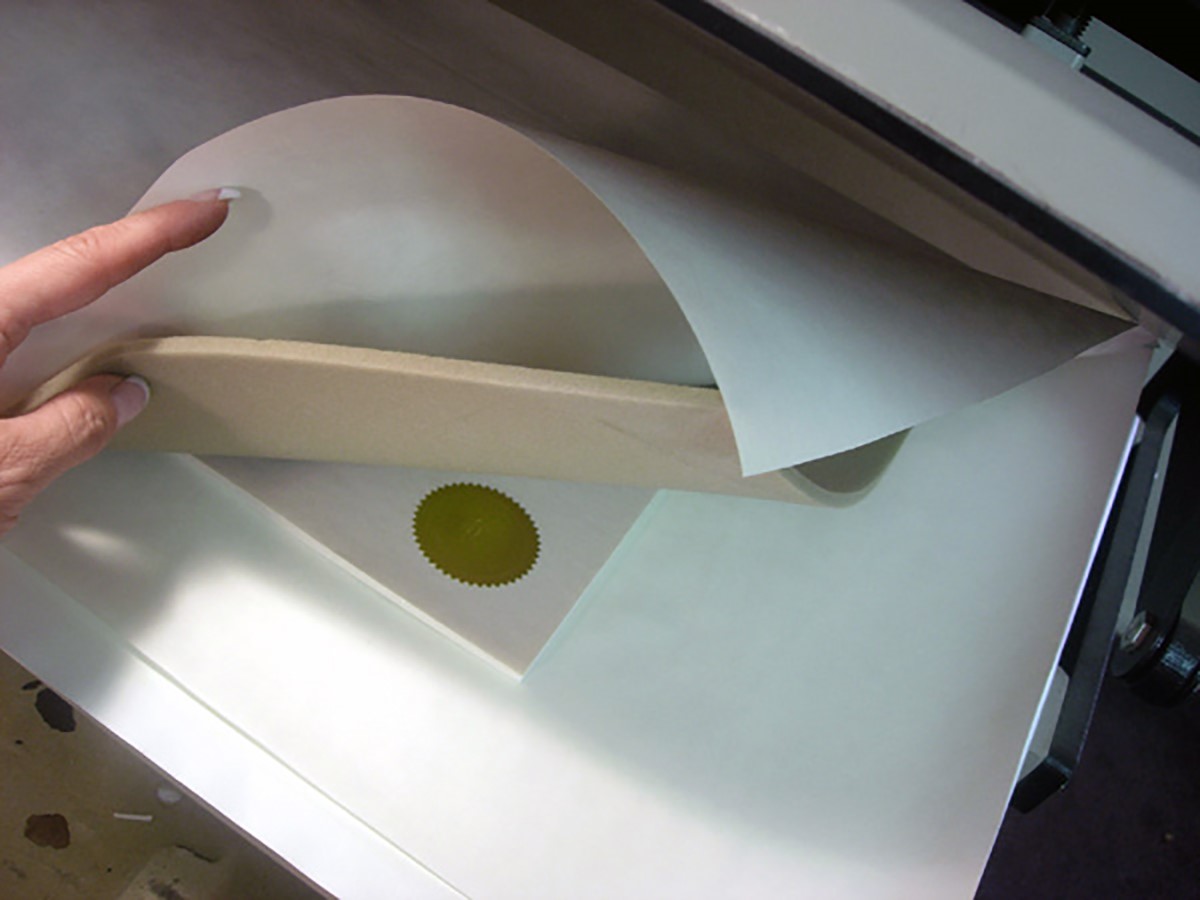 Photo 1
Photo 1
Preliminary wet and spray adhesive tests (clockwise from top). Spray peels from hardboard; gel on EAGLECELL® is well bonded but shows slight honeycomb; gel on half of a ½" birch panel bonds well; gel on Sintra easily pulls off.
Substrates are considered numerous times during any frame design session, whether consciously or subconsciously. If the art in question is an irreplaceable heirloom; an unstretched original canvas painting vs. digital canvas; or Yupo with alcohol ink or thickly layered acrylic, understanding what may be the correct substrate of choice for any mount will be determined by the art, its substrate, and the medium. And there are times the art substrate is a perfect candidate for dry mounting, while the medium created on it may not be.
Distributed by Legion Paper, Yupo® is a bright white, smooth surface, synthetic (polypropylene) substrate that has a non-porous surface which repels water. Originally developed for printed ads, signage, and short term publication, it is currently very popular as a fine art substrate with artists. Adhesives have been developed to accommodate the needs of bonding these commercial synthetics to a substrate for presentation including high tack pressure-sensitive and rollers, and low temperature, permanent, dry mount HA board, but fusing original art to those same substrates is another story.
Adhesives
A number of Yupo instructors and artists online suggest mounting completed originals with acrylic gel paste as an adhesive. Though true that liquid acrylic mediums and PVA may be used as wet adhesive within mixed media art for bonding porous materials, synthetics do not absorb. Yupo originals less than 22 x 30" are being mounted to cradled boxes or ⅜" hardboard using medium. Liquid medium is very lightweight and having no viscosity, soaks into the board leaving little bonding capability for non-absorbent synthetic paper.
Legion's Recommendations for Mounting Yupo flier suggests Acrylic gel medium, heavy duty, extra strong white glue (Aleene's Original Tacky Glue®, Elmer's® Glue All® Extra Strong); Neschen Gudy® 831 Fine Art Pressure Sensitive Film; MountCor® Permanent Heat Activated Board, Beva® 371 Heat Activated Film, and HA mountboards that bond at or below 160˚F. Fortunately, they are suggesting this as a prequel to painting, so as not to damage the surface-sensitive finished art, but some of these suggestions are less than perfect.
Golden Extra Heavy Gel Medium is a thick paste that will bond Yupo to an absorbent rigid substrate, but the end results may not have the desired tear strength. Golden Artist Colors was contacted about use of their gel products for bonding synthetic papers and they firmly stated, "…they do not endorse the use of their (gel) products with Yupo, and use of it must be considered experimental by nature." (Photo 1)
 Photo 1
Photo 1
Preliminary wet and spray adhesive tests (clockwise from top). Spray peels from hardboard; gel on EAGLECELL® is well bonded but shows slight honeycomb; gel on half of a ½" birch panel bonds well; gel on Sintra easily pulls off.
Bond Failure
It is the incompatibility of materials that allows for bond failure when working with synthetics. The above mentioned gel is a fabulous adhesive for the fusion of porous materials. The gel bonds to the porous substrate—hardboard, panel or box—but cannot aggressively hold to the Yupo allowing it to be pulled from the substrate. The adhesive remains well fused to the board, it's the Yupo bond that lets go. Since Yupo cannot absorb, any guarantee of long term fusion may not be possible.
The same is true for pressure-sensitive adhesive (PSA). Select only high tack films or self-adhesive products that will effectively bond layers for dependable long term fusion. In an attempt to achieve surface smoothness Yupo artists are requesting Gatorboard, Dibond or Sintra as a substrate. Like Yupo, Dibond and Sintra do not absorb adhesives so PSA may be an option, but not manually applied.
P-S Mounting
Neschen gudy® 802 is a transparent, permanent, high tack, waterbase, polyacrylate (polyester) PSA film for mounting photos or digital graphics to smooth PVC, Gator, polystyrene, polycarbonate, and aluminum composite substrates. It is currently being used in Europe for bonding Yupo with rollers to large scale ACM (like Dibond). Gudy 831 uses a long-fiber non-woven paper carrier coated on both sides with high tack, waterbased, acrylic adhesive, is acid and solvent-free, and has passed the Photographic Activity Test (ISO-18916). When manually applied gudy 831 does not meet tear strength requirements, but with a roller it was aggressive enough for Yupo. KoolTack InstaMount is a commercial pressure-sensitive board that has also tested well with Tyvek and Yupo. (Photo 2)
 Photo 2
Photo 2
Watercolor painted Yupo, mounted with gudy 831 to Sintra, mounted to 2" deep cross-braced wood cradle for 4x8' large scale gallery no-frame styling.
Though pressure-sensitive adhesives may be manually applied it is ill-advised when applying high tack PSA to smooth substrates. First, the adhesive is aggressive and does not allow for repositioning; second, there are two steps—adhesive to substrate, then art to adhesive—making it difficult to prevent trapped air, and the larger the mount the more difficult the application. And working in a designated clean room is advised to control dust and dirt.
Dry Mounting
Permanently mounting Yupo is not restricted to cold methods. Since Yupo cannot be used with laser printers many people think it is heat sensitive. Sheet polypropylene has a temperature tolerance of >275°F with a melt point of 338°F. In a laser printer, paper passes through rollers in the fuser assembly where it heats up to 390°F to bond plastic toner to paper. A dry mount press is far lower than that, so the question is not the heat, but which HA or P-S adhesive will bond to synthetic paper.
Not all HA boards are Yupo friendly. Testing has verified that 100% polyester—like an encapsulated chart—may bode well on many HA products but polyethylene, polypropylene, polyester and nylon may not. MountCor and MountCor Canvas bond at 130°F and both love Yupo, Tyvek, and polyester encapsulates. Generally a more rigid substrate, often ½" thick, will be required when placed in a float frame, and countermounting will be necessary for thinner ³⁄₁₆" HA or PS boards larger than 24x36”, even when placed in a float frame.
Mixed Media on Yupo
I recently received a call form an artist working on heavyweight 144# Yupo as a mixed media of collaged papers and thick impasto acrylics, very 3D. She was hoping to mount about 20 pieces of 20x26" Yupo to wooden cradles as unglazed originals for an upcoming show. Unpainted Yupo mounts wonderfully to numerous rigid substrates including Sintra, Gator, cradles, and hardboard, but the application techniques prevented proper mounting to be achieved because of the applied thick, uneven paint medium.
Concerns involved permanently mounting the painted Yupo to a substrate that could fully support the art substrate and also allow for the mounted art to be placed in a 1½" float frame with ¼" side space, ¼" face space, so the substrate of choice needed to have some thickness, preferable about ½". (Diagram 1) So the challenge is what to mount to and with what adhesive. This artist can't use P-S roller application because of the 3D quality of the art, but is currently testing manual application to Gator and ¼" birch panel using wet Miracle Muck, Aileen's Tacky, and Gel Medium for tear strength and ultimate permanency.
 Diagram 1
Diagram 1
Mixed media art on Yupo manually mounted to ½" Gatorboard, lifted in a float frame to desired depth.
Glazed vs. Unglazed
Another consideration is glazed vs. unglazed art and the durability of a substrate it may be bonded to. Unglazed art has its own issues, as open-air display is a flush mount to the edge of the substrate with no protection against surface denting by objects being leaned against it, so there is a strong argument against use of HA foam for open-air mounts because of surface softness. A float frame helps prevent a painted surface when face down against the floor, but cannot protect contact with edges or corners of other frames when carelessly stacked against a wall.
If glazed, MountCor or MountCor Canvas would have be a good choice for its tear strength and low bonding temperature, but being an HA board disallowed it to be mounted, at any temperature because of softening the acrylic could potentially transfer a sponge texture to the acrylic or flatten areas of it. If the art had been temperature safe, using a sponge mount technique to protect the uneven art surface during mounting would have worked. (Photo 3)
 Photo 3
Photo 3
The mounting package is stacked bottom release paper, 4-ply rag substrate, adhesive, letterhead with embossed seal (art), sponge overlay foam, and top release paper.
Sponge Mount
The thin overlay foam (sponge overlay) that is required as part of the vinyl laminating material package for a mechanical or hot vacuum press, is the integral layer required for successful sponge mounting. The sponge should be either ¼" or ½" sponge available from laminate manufacturers. Do not use any other sponge alternate such as the thin sponge, often called craft foam, or upholstery foam rubber for furniture. Some sponges may have a higher degree of petroleum content in them that could outgas or stick to artwork. The sponge must cover the entire project not just the three dimensional portion of the art. This prevents an edge pattern or shape from being indented into a foamboard substrate.
Final Mount
Obviously selecting a substrate is only half the problem. A non-absorbent synthetic also requires a compatible adhesive, mounting technique, tear strength, glazing (or not) and display capabilities to meet the artists needs and desires. If only they would always consider mounting their Yupo before painting on it.
For additional reading on Yupo see PFM articles "Yupo and Other Synthetics", November 2015 and "Mounting Synthetic Papers", January 2016. For "Sponge Mounting" see PFM August 2007.
END
Copyright © 2023 Chris A Paschke
For more articles on mounting basics look under the mounting section in Articles by Subject.
Additional information on all types of mounting is found in:
The Mounting and Laminating Handbook, Second Edition, 2002,
The Mounting And Laminating Handbook, Third Edition, 2008 and
Creative Mounting, Wrapping, And Laminating, 2000 will teach you everything you need to know about getting the most from your dry mount equipment and materials as an innovative frame designer.
All books are available from Designs Ink Publishing through this website.
Chris A Paschke, CPF GCF
Designs Ink
Designs Ink Publishing
785 Tucker Road, Suite G-183
Tehachapi, CA 93561
P 661-821-2188
chris@designsinkart.com